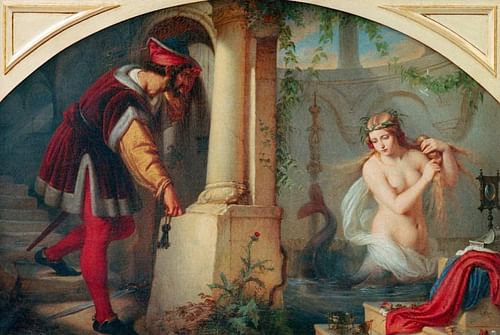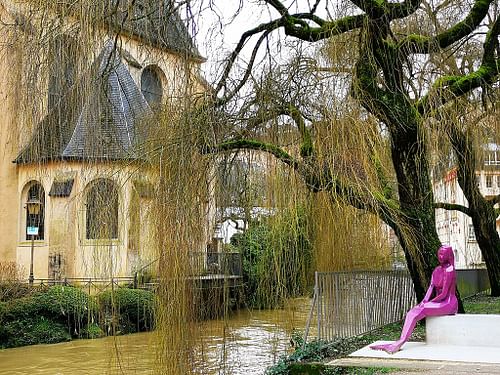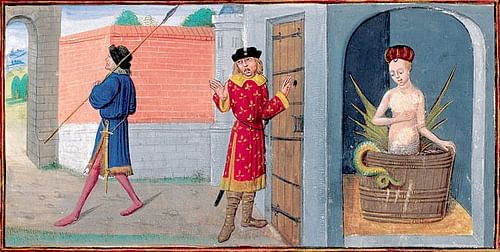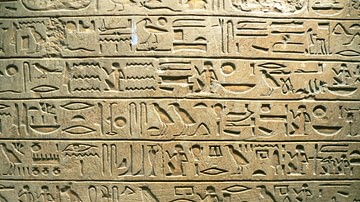
Melusine (pronounced Mel-ew-seen, also given as Melusina) is a legendary figure from European folklore depicted as a mermaid, sometimes with two tails, as a serpent from the waist down, or as a dragon. She is associated with the ruling houses of Anjou, Lusignan, and Plantagenet and supposedly warned nobles of these houses of impending death or change.
Also known as Melisande, her tale is best known from the work of the 14th-century French writer Jean d’Arras who wrote his Roman de Melusine at the request of Jean, duc de Berry (Duke of Berry, l. 1340-1416), and presents her in a sympathetic light. According to the legend, and d’Arras’ work, Melusine was cursed by her mother to become half-serpent every Saturday until she married a man who would respect her privacy on Saturdays and not look upon her or accept her as she was. She marries the nobleman Raymondin, promising to make him wealthy and famous, on the condition that he leave her alone every Saturday. Raymondin keeps his promise, and Melusine does the same, until he is persuaded by family to spy on her one Saturday in her bath. When he breaks his vow to her, she leaves him, returning only to visit her children or fulfill the obligations of the curse to warn of death or announce a change in fortunes.
The tale of Melusine is similar to those of the Swan Maiden and Valkyrie from Germanic and Norse mythology in which a mortal man marries a supernatural woman who either simply expects him to respect her privacy and personal rights or makes that a condition of their union, who is then betrayed by her husband, leaves him, and forces him to embark on a quest to win her back. In the Melusine legend, however, the male characters who betray their promise do nothing to win their wives back because they understand there is nothing to be done.
The Melusine story took many forms besides the traditional tale by d’Arras and was known in France, Britain, Germany, and Luxembourg as well as other regions. She is the subject of children’s tales, musical pieces, poetry, paintings, sculptures, and video games and appears as the logo of the world-famous Starbucks Corporation. She is also said to have inspired the story of The Little Mermaid by Hans Christian Anderson, and in Czech folklore, her name is attached to howling winds which are believed to be Melusine wailing for her lost children after she is betrayed by her husband.
Melusine’s Story
The legend begins with the story of Melusine’s parents – the nobleman Elinas (either from England or Scotland) and the mysterious woodland beauty Pressine. Elinas has recently lost his wife and goes hunting to distract him from his grief. In the forest, he comes to drink at the Well of Thirst and hears Pressine singing nearby. They return to his hunting lodge and talk through the night, and Elinas falls in love with her and asks her to marry him. Pressine agrees, noting how the devotion he showed to his first wife promises the same for his second. She makes him swear an oath to one condition, however, that he never try to see her at the birth of any of their children. Elinas agrees, and the two become happily married.
In time, Pressine gives birth to triplets, three girls – Melusine, Melior, and Palatine – and when Elinas hears the news, he is overcome with joy and rushes to the bedchamber to see them, forgetting his oath. Pressine is outraged, calling him a traitor to his word, and then takes the girls and spirits them away to the Isle of Avalon, leaving Elinas to mourn his loss for the rest of his life. Pressine is also in mourning over the loss of her true love, however, and she brings the girls to a high mountain each morning where they can look out upon Elinas’ realm and tells them they would be living there if their father had only kept his word.
When the girls reach the age of fifteen, Pressine tells them the whole story, and both Melior and Palatine agree it was unfortunate but also understandable that, in a moment of happiness, their father forgot his promise. Melusine remains silent, however, and begins plotting her revenge on the man who hurt her mother and forced their exile to Avalon. She convinces her sisters to help her, and together they use their magical powers to seal Elinas inside a mountain along with all of his treasure. Scholar Bettina L. Knapp describes what happens next:
Subsequently, the daughters returned to their mother and, expecting to be praised for their action, met with her wrath. Aghast at her daughters’ cruelty, Pressine told them that, by incarcerating their father, they had destroyed the only happiness she had ever experienced – his love for her. The punishments she meted out to her daughters were severe: Melusine, who had initiated the horrendous act, would, like Cain who killed his brother, go through life with the knowledge of her transgression and pain of its consequences: every Saturday the lower half of her body, from the umbilicus down, would assume the form of a serpent. If she found a man willing to marry her, he would have to promise not to look at her on Saturdays, nor ever reveal the taboo to anyone. As long as he adhered to the pact, Melusine would be capable of extraordinary achievements: the building of great fortresses, multiple towns, the amassing of inordinate wealth. She would bear many children, thus creating the great Lusignan lineage. If, on the other hand, her husband violated the oath, she would not only return to and retain her serpent form until Judgment Day, but each time the Lusignan fortresses changed hands or a descendent died, she would appear in the environs in her serpentine form for three days of painful lamentation. (35)
Melusine is then banished from Avalon, while Melior is sealed inside a castle for life, and Palatine is imprisoned in the same mountain as her father. Melusine settles by a stream in the woods of France near Poitiers where, one day, she meets the nobleman Raymondin who is distraught because he has just killed his uncle in a hunting accident. She consoles him and offers him advice on how to explain the death to his family, and he falls in love with her. When he asks her to marry him, she agrees, telling of all the wonderful things she will be able to do for him, but stipulates that he must promise to leave her alone every Saturday, a condition he swears he will abide by.
The couple is married for over ten years during which Melusine provides Raymondin with all of the land, wealth, and power her mother said she would as well as ten children. Depending on the version of the legend, all or most of the children are deformed in some way but are still accepted and loved by their parents. One day, however, Raymondin’s family begins questioning why Melusine must have Saturdays to herself and why she never attends Mass with the rest of the family. Raymondin begins wondering if his wife is unfaithful to him, gives into his insecurities, spies on Melusine one Saturday while she is bathing and learns her secret, and then denounces her as a "false serpent" publicly. His betrayal means there is no hope of Melusine ever living a normal life again.
She flies out the window in the form of a dragon (or, in another version, leaps into a river and swims away) only returning to visit her children or, in accordance with her mother’s curse, to mark the passing of the family fortresses and lands to other hands or the death of a family member. In some versions of the legend, she eventually finds herself among creatures similar to herself and starts a new life there, leaving only to fulfill the obligations of her curse. In others (or variations on the same one), the curse becomes unbearable finally and she begs her mother to give her a new body. Pressine, still unable to forgive her, obliges by giving her a man’s body, which conflicts with her feminine soul, and she leaves her in this condition for the rest of her life. The only time she shapeshifts is when she becomes a dragon who returns to her former home to continue fulfilling the obligation of the original curse.
Origin & Motif
The Melusine legend is a variation on two types of folktale, the first having to do with the lying-in taboo and the second with the Swan Maiden or Valkyrie. Women in the Middle Ages were considered unclean after childbirth and also too physically weak to resume their usual responsibilities for 10 to 20 days after giving birth. During this time, the husband was supposed to leave her alone to be attended by female servants or female members of the family. If the husband failed in this, some form of bad luck would follow. Tales concerning the lying-in taboo illustrated this cultural belief while also providing an entertaining story.
The Swan Maiden/Valkyrie motif comes from Germanic and Norse mythology and involves a supernatural woman in the form of a swan who comes to bathe in a lake or stream, shedding her swan skin. An unmarried man steals the skin (in the case of the Swan Maiden) or clothes (with the Valkyrie) and hides it, trapping the Swan Maiden (or Valkyrie) on earth and enticing her to marry him. In time, the husband either betrays his wife by destroying the skin or clothes – at which point she leaves him – or their children find the skin/clothes and return them to their mother – allowing her to fly away. This usually results in the husband being forced to embark on a quest to prove his worth to his wife and bring her back home.
In Slavic folklore, this motif figures in two tales concerning the witch Baba Yaga – The Frog Princess and Maria Morevna – both focusing on the efforts the husband characters must go to in order to prove themselves to the women they have betrayed. In both, the husband has either explicitly or implicitly agreed to a condition set by his wife, which he then purposefully ignores, and according to the supernatural rules governing the union, the wife is spirited away. After a number of ordeals, the husband is redeemed and wins his wife back.

In these tales, and others like them, the husband character is much more active than Elinas and Raymondin of the Melusine legend, but all touch on what seems to have been an ancient motif encouraging marital fidelity and trust. The common theme in all the tales is how misfortune follows a man who breaks faith with a wife who has made him a success. The lying-in taboo at the heart of the Pressine section of the legend is mirrored in the Melusine-Raymondin part of the tale in that watching one’s wife bathe, without her knowledge, was considered just as taboo as seeing her during her period of lying-in; both were an invasion of a woman’s privacy during a time when she was supposed to be left alone. This same motif appears in myths and legends from many ancient cultures, probably best-known from the tale of Artemis and Acteon; when Acteon spies on Artemis bathing without her knowledge or consent, she turns him into a stag, and he is torn apart by his own hunting dogs.
Link with Noble Houses
In all these tales, the man is at fault for breaking a taboo or a trust, and the same is true in the Melusine legend. The difference in this tale is that the men seem to understand the futility of trying to win their wives back, even though they clearly loved them, adding a tragic dimension to the story and elevating Melusine as a heroine undeserving of her fate. The legend was purposefully revised by Jean d’Arras between c. 1387-1393 for political purposes to make Melusine more sympathetic as the foundress of the Lusignan Dynasty. The basic elements of the story itself are not that different from many others of its type, however, as noted by scholars Maria Leach and Jerome Fried:
The breaking of the taboo, reduplicated in this story by the incident of Pressine, is itself simply another version of the offended supernatural wife motif told by others and worked into this tale so that it would not be lost. Parallels of the Melusine story are found in several parts of the world. (705)
D’Arras altered the offended supernatural wife motif to make sure an audience would understand Melusine as a good Christian beloved by her subjects who was unjustly cursed by a hard-hearted mother and betrayed by a faithless husband. The work was commissioned by Jean, duc de Berry of the House of Lusignan best known as a patron of the arts and collector of illuminated manuscripts. An image of Melusine as a dragon, flying over the fortress of Lusignan, appears in the famous illuminated manuscript Les Très Riches Heures du Duc de Berry (begun c. 1412-1416) commissioned by the duke.
The duke requested the Melusine tale from d’Arras as part of a propaganda campaign. The story ends in d’Arras’ version with Melusine returning to the castle of Lusignan in 1374 just before the duke’s forces liberated it from the English. Her cries signaled the duke’s victory and the castle changing hands, establishing the duke as the rightful heir of Melusine who was thought to have magically built the fortress when she was first with Raymondin. In d’Arras’ version of the story, then, the duke is linked directly to the founder of the Lusignan house, establishing his legitimacy.
The Duke of Berry is only one noble to claim descent from Melusine, however, as she was also claimed as an ancestor by the nobility of Britain, Germany, and Luxembourg. Richard I of England (r. 1189-1199) claimed Melusine as a direct ancestor, supposedly boasting of his relationship with a supernatural entity he felt brought him luck. Other noble houses similarly linked themselves with the legend at least 200 years before Jean d’Arras wrote his version of Melusine, and she still appears on the family heraldry of a number of European noble families.
Conclusion
Why the nobility of medieval, Catholic Europe chose to link themselves to a supernatural entity who, in all the versions of the story, does not attend Mass, is a question scholars still debate and discuss. The 14th-century French writer Couldrette links Melusine to the Arthurian legends in his Roman de Melusine through the figure of the Good Knight of England, a member of King Arthur’s court, who goes in search of the treasure of Melusine’s father. He fails in his quest, however, as it has been decreed that Melusine’s son Geoffrey of the Great Tooth will defeat the treasure’s guardian and no other.
As the Arthurian Legend was embraced by a number of Europe’s nobility, Melusine came to be regarded as belonging to each by their respective writers. Although a supernatural entity, she is given Christian values and virtues by most if not all writers of medieval literature, and her children were regarded as heroic foundational figures by the various houses of Europe accordingly.
Knapp offers a Jungian interpretation of the legend which, she claims, people would have responded to on a subconscious level as they do with all archetypal figures from scripture, myth, and legend:
That Melusine, like her mother, is associated with a fountain located in the heart of a forest, suggests a capacity in both of them to alter, cleanse, heal, and regenerate an ailing psyche. The ever-renewing waters from a fountain, emerging from the depths of the earth (the unconscious), rising into the air (consciousness), may indicate a timeless as well as a restless and continuously mobile quality in mother and daughter. (41)
Knapp points out that both Elinas and Raymondin are despondent when they first meet Pressine and Melusine and, in both cases, are healed of their psychic wounds, allowing for them to experience wholeness and material success. According to this interpretation, the nobles of the various kingdoms were responding to the symbolism of the tale which resonated with the Christian message of redemption and completeness.
However she came to be regarded as the great ancestor of European nobility, her popularity has endured for hundreds of years. In the present day, Melusine is featured in video games, poetry, novels, and is the often-controversial figure of the Starbucks logo. Objections to her Starbucks image frequently associate her with a siren, mermaid, or with Lilith, Adam’s first wife before Eve was created, but Melusine is quite different from any of these. She does not lure anyone to certain doom nor is she associated with any kind of rebellion against the Christian God. She is always presented, in Shakespeare’s phrase, as one "more sinned against than sinning" and, besides the mermaid’s tale, only shares in the qualities of the others mentioned in her seemingly endless capacity to entrance, fascinate, and inspire.







